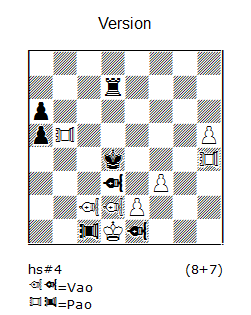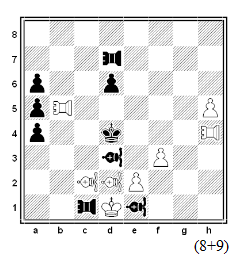| No.329 S.K.Balasubramanian (India) |
Original Problems, Julia’s Fairies – 2013 (II): May – August →Previous ; →Next ; →List 2013(II) Please send your original fairy problems to: julia@juliasfairies.com |
No.329 by S.K.Balasubramanian – Fireworks of Chinese-Indian effects! (JV)
Definitions:
PAO(PA): Moves as Rook, but captures only by hopping over a hurdle to any square beyond.
VAO(VA): Moves as Bishop, but captures only by hopping over a hurdle to any square beyond.
|
No.329 S.K.Balasubramanian
India
original-03.06.2013
 hs#4 (9+6)
PAOs: a5, b1, c7, h4 VAOs: b2, c2, c3, d1 Solution: (click to show/hide)
|



Full of line openings, critical moves and anti-batteries. Action packed solution ! Great execution Bala !
№329 – This is a very beautiful and complex problem by Mr.Balasubramanian, although there is only one solution! In general, Mr.Balasubramanian has a special feeling for harmony and almost all of his problems present interesting complexes. A typical example is this HS#4. [/img]
[/img]
Thematically here everything is almost brilliant. I think that it is not a great trouble that the problem has only one phase – two phases with such content are obviously impossible..
But there is another – much more important question: is everything perfect here in technical terms?
In such cases, every author can answer to this question firstly himself. Here is necessary a specification: the technical weaknesses must be identified and then analyzed carefully and more detailed. In my practice I use a special plan for this work – the cons are identified and I try to remove at least some of them. Sometimes this process of improvements is too long – it takes a week, month or even year!
Of course, not everything can be fixed. But very often positive technical improvements are possible – in some degree.
As a first step in this direction, it is needed to analyze the functions of white and black pieces which play the role of cook (dual)-stoppers.
In the problem of Balasubramanian, in my opinion, an unpleasant technical piece (cook/dual – stopper) is the white Ph7. It prevents the move VAh7.
Why a technical white pawn, that stands on the seventh horizontal in the role of cook (dual)-stopper is a bad figure –as a general conclusion for all possible problems?The answer is not difficult: such pawn has a significant potential as fighting force (possibility of promotions in different white pieces) but this power remains in thematic aspect unused. This weakness, at first sight minimal, very often is a specific signal for the non-optimal use of the material in technical&aesthetical attitude. On the other hand, this Pawn is a real danger for cooks and duals – because of the possibility to promote to strong figures – Queen, Rook, etc.
Analyzing carefully Balasubramanian’s problem we note that there is also a rather questionable role of the black PAOc7. It is a rear piece in the masked black battery King/PAO. But here the Pao doesn’t have any thematic functions! Can we put here a black Rook on c7 and remove с6 pawn?
Unfortunately not, while the white pawn is standing on h7 – in this case many cooks are possible, for example: 1.h7-h8=Q Kc4-b3 2.Qh8-d4 Rc7-f7 3.VAc2-e4 Rf7-f1 4.Qd4-a4 + VAd1xa4 #. For this reason, probably, author uses black PAO on c7 and and black Pawn on c6.
My analysis showed that the cited deficiencies can be removed. I give just one example that is of course not a “letz form” – surely, other, better improvements are possible:
[img
1.VAc2-g6 VAd1-a4 2.PAa5-f5 VAc3-a5 3.VAb2-e5 PAb1-b4 4.Pd2-d4+ Kc4-b3 # (Tested by Popeye 4,63)
The above is the solution of the source problem!
The solution of the version is:
1.VAd2-h6 VAe1-b4 2.PAb5-g5 VAd3-b5 3.VAc2-f5 PAc1-c4 4.e2-e4 + Kd4-c3 #
Thanks, Nicolas! My variation is a technical errors I beg on pardon! The right solution is of course: 1.VAd2-h6 VAe1-b4 2.PAb5-g5 VAd3-b5 3.VAc2-f5 PAc1-c4 4.e2-e4 + Kd4-c3 #.
No.329:
Dear Mr. Petko,
Thanks for your very very encouraging comments. Always, your comments are most valuable to me. I also did not like the presence of WPh7. In fact the version I published in Julia’s website (No.329) was only a second version [WCCT-P12(b)]. The original version was version WCCT-P12(a) which I composed initially and was almost identical to your suggested version & I am giving below my earlier version.
[img [/img]
[/img]
1.VAd2-h6 VAe1-b4 2.PAb5-g5 VAd3-b5 3.VAc2-f5 PAc1-c4 4.Pe2-e4+ Kd4-c3 #
I could find that Pa4 is not at all needed only after seeing the version you have suggested, Further it didn’t strike me that I could use a bRd7 instead of a bPAOd7+bPd6. Thanks for educating me.
Probably Mr. Seetharaman (or someone else — I am not remembering exactly) didn’t like in my WCCT-P12a, the army of 3 bP’s on a4 to a6. So, I preferred to shift everything by one square left which resulted in wPs on g5 & h7. The other reason why I chose version (b) was for better economy. Now I realize that I should have worked to improve only my earlier version by using bRd7 instead of bPAO.
Once agains thanks for your critical comments.
—- Bala